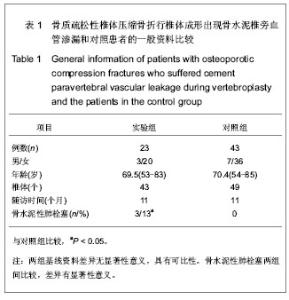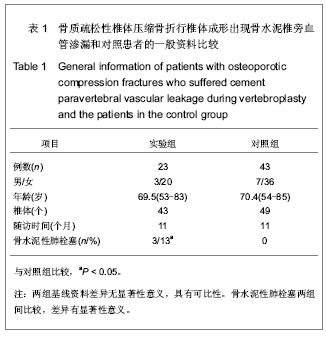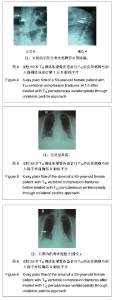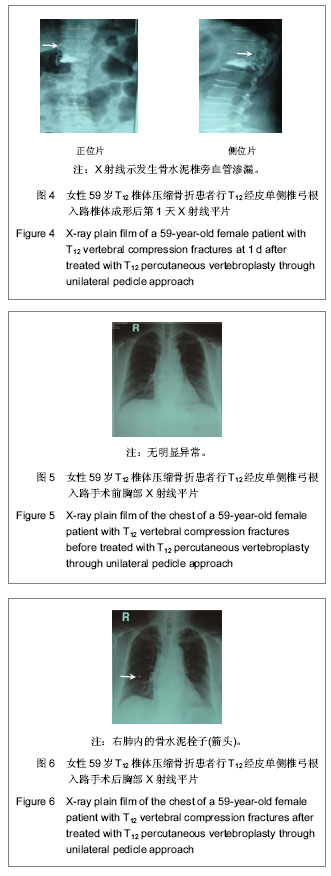Chinese Journal of Tissue Engineering Research ›› 2013, Vol. 17 ›› Issue (47): 8275-8281.doi: 10.3969/j.issn.2095-4344.2013.47.021
Previous Articles Next Articles
Relationship between paravertebral vascular leakage and pulmonary cement embolism during percutaneous vertebroplasty
Wang Shi-jun, Yi Xiao-dong, Li Chun-de, Liu Xian-yi, Lu Hai-lin, Liu Hong, Li Hong, Yu Zheng-rong, Sun Hao-lin
- Department of Orthopedics, Peking University First Hospital, Beijing 100034, China
-
Revised:2013-08-27Online:2013-11-19Published:2013-11-19 -
Contact:Yi Xiao-dong, Chief physician, Department of Orthopedics, Peking University First Hospital, Beijing 100034, China yi_xd@263.net -
About author:Wang Shi-jun☆, M.D., Attending physician, Department of Orthopedics, Peking University First Hospital, Beijing 100034, China doctorwang444@yahoo.com.cn
CLC Number:
Cite this article
Wang Shi-jun, Yi Xiao-dong, Li Chun-de, Liu Xian-yi, Lu Hai-lin, Liu Hong, Li Hong, Yu Zheng-rong, Sun Hao-lin. Relationship between paravertebral vascular leakage and pulmonary cement embolism during percutaneous vertebroplasty[J]. Chinese Journal of Tissue Engineering Research, 2013, 17(47): 8275-8281.
share this article
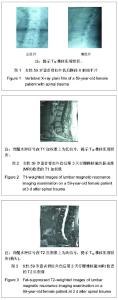
2.2 参与者数量分析 纳入134例患者中共有66例具备完整的术前及术后胸部X射线资料患者,均在局麻下顺利完成手术,术中及术后均未发生严重并发症。最后随访时间1-24个月,平均11个月,无脱失。 2.3 术中椎旁血管骨水泥渗漏及骨水泥性肺栓塞发生率 在134例患者中共有23例出现骨水泥椎旁血管渗漏,占17.2%。出现椎旁血管渗漏的23例中有3例出现骨水泥性肺栓塞,占出现椎旁血管渗漏患者的13%,占全部患者的2.2%,对照组43例未出现椎旁血管渗漏的患者均未出现骨水泥性肺栓塞。由于并非全部患者均行术后胸部X射线检查,可能低估骨水泥性肺栓塞的发生率。 2.4 术中椎旁血管骨水泥渗漏与骨水泥性肺栓塞的关系 实验中存在骨水泥椎旁血管渗漏组23例,其中3例并发无症状性骨水泥性肺栓塞占出现椎旁血管渗漏患者的13%。发现肺部骨水泥栓子的患者术后均无血氧饱和度下降﹑呼吸困难﹑呼吸急促﹑紫绀﹑咳嗽﹑咯血﹑血压下降﹑心动过速﹑胸闷﹑心慌﹑胸痛﹑头晕等不适,并且在随访的过程中同样未出现肺部症状。未出现骨水泥椎旁血管渗漏组43例,均未出现骨水泥性肺栓塞,两组间比较,差异有显著性意义(P=0.039),见表1。术中出现骨水泥椎旁血管渗漏后,发生骨水泥性肺栓塞风险增加,提示术中一旦出现骨水泥椎旁血管渗漏,尽管患者并无胸部症状仍应警惕骨水泥性肺栓塞可能。 2.5 典型病例分析 女性患者,59岁。不慎摔倒致腰背部疼痛6 h入院。T12棘突叩痛(+),双下肢感觉肌力正常,术前疼痛目测类比评分7分。X射线示T12椎体压缩骨折,见图1;腰椎MRI示新鲜椎体压缩骨折,见图2,3。"
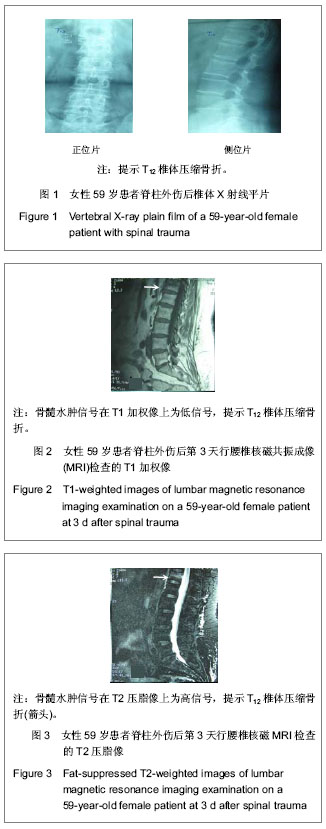
| [1] Galibert P, Deramond H, Rosat P, et al. Preliminary note on the treatment of vertebral angioma by percutaneous acrylic vertebroplasty. Neurochirurgie.1987;3(2):166-168.
[2] 李春海,刘尚礼,叶伟,等.高黏度骨水泥在经皮椎体成形术中的应用[J].中华骨科杂志,2007, 27(4):259-262.
[3] 韦西江,苏汝堃.经皮椎体成形填充剂骨水泥渗漏的研究现状[J]. 中国组织工程研究,2012,16(47):8853-8863.
[4] 唐志宏,邹国耀,肖颖,等.胸腰段椎体内血管分布与安全区内穿刺减少骨水泥的渗漏[J].中国组织工程研究,2013,17(3):387-391.
[5] 王冰,米川,施学东.经皮椎体成形术与开放性手术治疗脊柱转移瘤[J].中国脊柱脊髓杂志,2012,22(3):246-251.
[6] Kao FC,Tu YK,Lai PL,et al.Inferior vena cava syndrome following percutaneous vertebroplasty with polymethylmethacrylate.Spine.2008;33(10):E329-333.
[7] Manson NA, Phillips FM. Minimally invasive techniques for the treatment of osteoporotic vertebral fractures. Instr Course Lect. 2007;56:273-285.
[8] Martin JB, Jean B, Sugiu K, et al. Vertebroplasty: clinical experience and follow-up results. Bone. 1999;25(2 Suppl): 11S-15S.
[9] Mathis JM, Barr JD, Belkoff SM, et al. Percutaneous vertebroplasty: a developing standard of care for vertebral compression fractures. AJNR Am J Neuroradiol. 2001; 22(2):373-381.
[10] Chou CW, Teng CL, Hwang WL. Bone cement-induced pulmonary embolism in a myeloma patient. Br J Haematol. 2013;161(4):459.
[11] Cotten A, Dewatre F, Cortet B, et al. Percutaneous vertebroplasty for osteolytic metastases and myeloma: effects of the percentage of lesion filling and the leakage of methyl methacrylate at clinical follow-up. Radiology. 1996;200(2): 525-530.
[12] Lee BJ, Lee SR, Yoo TY. Paraplegia as a complication of percutaneous vertebroplasty with polymethylmethacrylate: a case report. Spine (Phila Pa 1976). 2002;27(19):E419-422.
[13] Harrington KD. Major neurological complications following percutaneous vertebroplasty with polymethylmethacrylate : a case report. J Bone Joint Surg Am. 2001;83-A(7):1070-1073.
[14] Wang LJ,Yang HL,Shi YX,et al.Pulmonary cement embolism associated with percutaneous vertebroplasty or kyphoplasty: a systematic review.Orthop Surg.2012;4(3):182-189.
[15] Kim HT, Kim YN, Shin HW, et al. Intracardiac foreign body caused by cement leakage as a late complication of percutaneous vertebroplasty. Korean J Intern Med. 2013; 28(2):247-250.
[16] Matouk CC, Krings T, Ter Brugge KG, et al. Cement embolization of a segmental artery after percutaneous vertebroplasty: a potentially catastrophic vascular complication. Interv Neuroradiol. 2012;18(3):358-362.
[17] Choe DH, Marom EM, Ahrar K, et al. Pulmonary embolism of polymethyl methacrylate during percutaneous vertebroplasty and kyphoplasty. AJR Am J Roentgenol. 2004;183(4): 1097-1102.
[18] Habib N, Maniatis T, Ahmed S, et al. Cement pulmonary embolism after percutaneous vertebroplasty and kyphoplasty: an overview. Heart Lung. 2012 ;41(5):509-511.
[19] Kim YJ, Lee JW, Park KW, et al. Pulmonary cement embolism after percutaneous vertebroplasty in osteoporotic vertebral compression fractures: incidence, characteristics, and risk factors. Radiology. 2009;251(1):250-259.
[20] Venmans A, Lohle PN, van Rooij WJ, et al. Frequency and outcome of pulmonary polymethylmethacrylate embolism during percutaneous vertebroplasty. AJNR Am J Neuroradiol. 2008;29(10):1983-1985.
[21] Anselmetti GC, Corgnier A, Debernardi F, et al. Treatment of painful compression vertebral fractures with vertebroplasty: results and complications. Radiol Med. 2005;110(3):262-272.
[22] Bernhard J, Heini PF, Villiger PM. Asymptomatic diffuse pulmonary embolism caused by acrylic cement: an unusual complication of percutaneous vertebroplasty. Ann Rheum Dis. 2003;62(1):85-86.
[23] 彭成忠,周春芳,曾钊,等 脊柱外固定和椎体成形注入骨水泥治疗老年胸腰椎骨折[J].中国组织工程研究,2013,17(4):582-587.
[24] MacTaggart JN, Pipinos II, Johanning JM, et al. Acrylic cement pulmonary embolus masquerading as an embolized central venous catheter fragment. J Vasc Surg. 2006;43(1): 180-183.
[25] Hiwatashi A,Yoshiura T,Noguchi T,et al.Usefulness of cone-beam CT before and after percutaneous vertebroplasty.AJR Am J Roentgenol.2008;191(5):1401-1405.
[26] Cadeddu C,Nocco S,Secci E,et al.Echocardiographic accidental finding of asymptomatic cardiac and pulmonary embolism caused by cement leakage after percutaneous vertebroplasty.Eur J Echocardiogr.2009;10(4):590-592.
[27] Bose R, Choi JW. Successful percutaneous retrieval of methyl methacrylate orthopedic cement embolism from the pulmonary artery. Catheter Cardiovasc Interv. 2010 ;76(2):198-201.
[28] Caynak B, Onan B, Sagbas E, et al. Cardiac tamponade and pulmonary embolism as a complication of percutaneous vertebroplasty. Ann Thorac Surg. 2009;87(1):299-301.
[29] Abdul-Jalil Y, Bartels J, Alberti O, et al. Delayed presentation of pulmonary polymethylmethacrylate emboli after percutaneous vertebroplasty. Spine (Phila Pa 1976). 2007;32(20):E589-593.
[30] Hodler J, Peck D, Gilula LA. Midterm outcome after vertebroplasty: predictive value of technical and patient-related factors. Radiology. 2003;227(3): 662-668.
[31] Duran C, Sirvanci M, Aydo?an M, et al. Pulmonary cement embolism: a complication of percutaneous vertebroplasty. Acta Radiol. 2007;48(8):854-859.
[32] Koch CA, Layton KF, Kallmes DF. Outcomes of patients receiving long-term corticosteroid therapy who undergo percutaneous vertebroplasty. AJNR Am J Neuroradiol. 2007; 28(3):563-566.
[33] Padovani B, Kasriel O, Brunner P, et al. Pulmonary embolism caused by acrylic cement: a rare complication of percutaneous vertebroplasty. AJNR Am J Neuroradiol. 1999; 20(3):375-377.
[34] Jensen ME, Evans AJ, Mathis JM, et al. Percutaneous polymethylmethacrylate vertebroplasty in the treatment of osteoporotic vertebral body compression fractures: technical aspects. AJNR Am J Neuroradiol. 1997;18(10):1897-1904.
[35] Lim SH, Kim H, Kim HK, et al. Multiple cardiac perforations and pulmonary embolism caused by cement leakage after percutaneous vertebroplasty. Eur J Cardiothorac Surg. 2008;33(3):510-512.
[36] Son KH, Chung JH, Sun K, et al. Cardiac perforation and tricuspid regurgitation as a complication of percutaneous vertebroplasty. Eur J Cardiothorac Surg. 2008;33(3):508-509.
[37] Jang JS, Lee SH, Jung SK. Pulmonary embolism of polymethylmethacrylate after percutaneous vertebroplasty: a report of three cases. Spine (Phila Pa 1976). 2002;27(19): E416-418.
[38] Freitag M, Gottschalk A, Schuster M, et al. Pulmonary embolism caused by polymethylmethacrylate during percutaneous vertebroplasty in orthopaedic surgery. Acta Anaesthesiol Scand. 2006;50(2):248-251.
[39] Yoo KY, Jeong SW, Yoon W, et al. Acute respiratory distress syndrome associated with pulmonary cement embolism following percutaneous vertebroplasty with polymethylmethacrylate. Spine (Phila Pa 1976). 2004; 29(14):E294-297.
[40] Kim SY, Seo JB, Do KH, et al. Cardiac perforation caused by acrylic cement: a rare complication of percutaneous vertebroplasty. AJR Am J Roentgenol. 2005;185(5): 1245-1247.
[41] François K, Taeymans Y, Poffyn B, et al. Successful management of a large pulmonary cement embolus after percutaneous vertebroplasty: a case report. Spine (Phila Pa 1976). 2003;28(20):E424-425.
[42] Stricker K, Orler R, Yen K, et al. Severe hypercapnia due to pulmonary embolism of polymethylmethacrylate during vertebroplasty. Anesth Analg. 2004;98(4):1184-1186.
[43] Monticelli F, Meyer HJ, Tutsch-Bauer E. Fatal pulmonary cement embolism following percutaneous vertebroplasty (PVP). Forensic Sci Int. 2005;149(1):35-38.
[44] Baumann A, Tauss J, Baumann G,et al. Cement embolization into the vena cava and pulmonal arteries after vertebroplasty: interdisciplinary management. Eur J Vasc Endovasc Surg. 2006;31(5):558-561.
[45] Venmans A, Klazen CA, van Rooij WJ, et al. Postprocedural CT for perivertebral cement leakage in percutaneous vertebroplasty is not necessary--results from VERTOS II. Neuroradiology. 2011;53(1):19-22.
[46] Venmans A, Klazen CA, Lohle PN, et al. Percutaneous vertebroplasty and pulmonary cement embolism: results from VERTOS II. AJNR Am J Neuroradiol. 2010;31(8):1451-1453.
[47] Baumann C, Fuchs H, Kiwit J, et al. Complications in percutaneous vertebroplasty associated with puncture or cement leakage. Cardiovasc Intervent Radiol. 2007;30(2): 161-168.
[48] Nussbaum DA, Gailloud P, Murphy K. A review of complications associated with vertebroplasty and kyphoplasty as reported to the Food and Drug Administration medical device related web site. J Vasc Interv Radiol. 2004;15(11): 1185-1192.
[49] Amoretti N, Hovorka I, Marcy PY, et al. Aortic embolism of cement: a rare complication of lumbar percutaneous vertebroplasty. Skeletal Radiol. 2007;36(7):685-687.
[50] Hierholzer J, Fuchs H, Westphalen K,et al. Percutaneous vertebroplasty -- the role of osseous phlebography. Rofo. 2005;177(3):386-392.
[51] Blinc A, Bozic M, Vengust R, et al. Methyl-methacrylate bone cement surface does not promote platelet aggregation or plasma coagulation in vitro. Thromb Res. 2004;114(3): 179-184.
[52] Righini M, Sekoranja L, Le Gal G, et al. Pulmonary cement embolism after vertebroplasty. Thromb Haemost. 2006; 95(2):388-389.
[53] Krueger A, Bliemel C, Zettl R, et al. Management of pulmonary cement embolism after percutaneous vertebroplasty and kyphoplasty: a systematic review of the literature. Eur Spine J. 2009;18(9):1257-1265.
[54] Krueger A, Bliemel C, Zettl R, et al. Management of pulmonary cement embolism after percutaneous vertebroplasty and kyphoplasty: a systematic review of the literature. Eur Spine J. 2009p;18(9):1257-1265.
[55] 姚晓光,张义武,刘连涛,等.经皮椎体成形和经皮椎体后凸成形治疗中的骨水泥渗漏[J].中国组织工程研究,2012;16(51): 9645-9649.
[56] 于方,方秀统,俞猛,等.球囊扩张椎体成形术中填充人工骨与骨水泥治疗椎体压缩性骨折疗效比较[J].中国骨与关节杂志,2012; 1(6): 582-586. |
| [1] | Wang Ling, Zhao Hong-xia, Hua Qiang. Percutaneous vertebroplasty, percutaneous kyphoplasty and expansive pedicle screw fixation for repairing primary osteoporotic thoracolumbar fractures [J]. Chinese Journal of Tissue Engineering Research, 2017, 21(3): 350-355. |
| [2] | Sun Shi-wei, Yang Long, Xie Shui-an, Wang Jian, Xu Ru-bin. Combined use of intraarticular and intravenous tranexamic acid in total hip arthroplasty [J]. Chinese Journal of Tissue Engineering Research, 2016, 20(48): 7149-7155. |
| [3] | Gu Yong, Wang Qiang, Xin Tian-wen, Yang Hui-lin, Chen Liang . Posterior cervical open-door expansive laminoplasty with mini-titanium plate: correlation between cervical sagittal alignment and repair effect [J]. Chinese Journal of Tissue Engineering Research, 2016, 20(44): 6570-6576. |
| [4] | Zhang Hui, Gao Zhong-yu, Xu Cai-yuan, Zhang Tong-xing, Zhang Tao. Vertebroplasty for osteoporotic vertebral compression fractures: missed diagnosis, severe vertebral compression, bone cement leakage and recurrent fractures in 225 cases [J]. Chinese Journal of Tissue Engineering Research, 2016, 20(35): 5256-5262. |
| [5] | Zhang Yi-long, Ren Lei, Sun Zhi-jie, Wang Ya-hui, Sun He. New vertebral compression fractures after vertebroplasty: association with osteoporosis and spinal sagittal imbalances [J]. Chinese Journal of Tissue Engineering Research, 2016, 20(35): 5263-5269. |
| [6] | Li Shi-hong, Liu Yang. Measurement of bone metabolism markers and changes of bone mineral density in patients with bone and joint disease and fractures in perioperative period [J]. Chinese Journal of Tissue Engineering Research, 2016, 20(35): 5290-5295. |
| [7] | Yu Hai-ming, Li Yi-zhong, Yao Xue-dong, Lin Jin-kuang, Pan Yuan-cheng, Zhuang Hua-feng,Wang Pei-wen. Percutaneous vertebroplasty or percutaneous kyphoplasty for Kummell’s disease with vertebral posterior wall collapse: how to treat individually? [J]. Chinese Journal of Tissue Engineering Research, 2016, 20(26): 3856-3862. |
| [8] | Liang He-sheng, Xiao Li-jun, Deng De-li . Posterior cervical single door and double door laminoplasty for repair of multilevel cervical myelopathy: motion range of cervical vertebrae [J]. Chinese Journal of Tissue Engineering Research, 2016, 20(22): 3235-3241. |
| [9] | Zhang Yi-long, Sun Zhi-jie, Wang Ya-hui, Ren Lei, Sun He . Osteoporotic vertebral compression fractures: correlation between number of fractured vertebrae and C7 plumb line/sacro-femoral distance ratio [J]. Chinese Journal of Tissue Engineering Research, 2016, 20(22): 3315-3321. |
| [10] | Yang Sen, Xu Tao, Sheng Wei-bin, Wang Guo-qi, Guo Hai-long . A systematic review on unilateral versus bilateral kyphoplasty for osteoporotic vertebral compression fractures [J]. Chinese Journal of Tissue Engineering Research, 2015, 19(8): 1306-1312. |
| [11] | Wang Bin, Gao Yi, Xu Jian-da, Xie Zi-kang, Shen Peng-fei, Zheng Chong, Qu Yu-xing. Adjustable and ordinary locking compression plates for the repair of osteoporotic distal radius fractures: comparison of radial length and wrist function recovery [J]. Chinese Journal of Tissue Engineering Research, 2015, 19(4): 584-589. |
| [12] | Chen An-gang, Zeng Ben-qiang, Yang Yong, Song Xiao-qiang, Hu Bing. Percutaneous vertebroplasty with bone cement for the treatment of osteoporotic thoracolumbar vertebral compression fractures [J]. Chinese Journal of Tissue Engineering Research, 2014, 18(52): 8371-8375. |
| [13] | Ma Gui-fu, Qian Yao-wen, Liu Lin, Luo Wen-yuan, Liu Shao-guang. A meta-analysis of unilateral versus bilateral balloon kyphoplasty in the treatment of osteoporotic vertebral compression fractures [J]. Chinese Journal of Tissue Engineering Research, 2014, 18(34): 5566-5571. |
| [14] | Mahmootjan•Muhammat, Zhu Shao-bo, Li Jing-feng, Jin Lin, Su Ri-han, Wang Xi. Two surgical methods for osteoporotic vertebral compression fractures: a meta-analysis on safety and efficacy [J]. Chinese Journal of Tissue Engineering Research, 2014, 18(22): 3551-3559. |
| [15] | Huang Xiao-nan. Percutaneous vertebroplasty for treatment of osteoporotic vertebral fractures: high-viscosity versus low-viscosity bone cement [J]. Chinese Journal of Tissue Engineering Research, 2014, 18(16): 2461-2467. |
| Viewed | ||||||
|
Full text |
|
|||||
|
Abstract |
|
|||||
